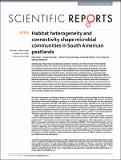Por favor, use este identificador para citar o enlazar a este item:
http://hdl.handle.net/10261/213270COMPARTIR / EXPORTAR:
 SHARE SHARE
 CORE
BASE CORE
BASE
|
|
| Visualizar otros formatos: MARC | Dublin Core | RDF | ORE | MODS | METS | DIDL | DATACITE | |

| Campo DC | Valor | Lengua/Idioma |
|---|---|---|
| dc.contributor.author | Oloo, Felix | es_ES |
| dc.contributor.author | Valverde Portal, Ángel | es_ES |
| dc.contributor.author | Quiroga, María Victoria | es_ES |
| dc.contributor.author | Vikram, Surendra | es_ES |
| dc.contributor.author | Cowan, Don A. | es_ES |
| dc.contributor.author | Mataloni, Gabriela | es_ES |
| dc.date.accessioned | 2020-06-04T06:30:25Z | - |
| dc.date.available | 2020-06-04T06:30:25Z | - |
| dc.date.issued | 2016 | - |
| dc.identifier.citation | Scientific Reports 6: 25712 (2016) | es_ES |
| dc.identifier.uri | http://hdl.handle.net/10261/213270 | - |
| dc.description | 8 páginas, 5 figuras. -- The first publication is available at https://www.nature.com | es_ES |
| dc.description.abstract | Bacteria play critical roles in peatland ecosystems. However, very little is known of how habitat heterogeneity affects the structure of the bacterial communities in these ecosystems. Here, we used amplicon sequencing of the 16S rRNA and nifH genes to investigate phylogenetic diversity and bacterial community composition in three different sub-Antarctic peat bog aquatic habitats: Sphagnum magellanicum interstitial water and water from vegetated and non-vegetated pools. Total and putative nitrogen-fixing bacterial communities from Sphagnum interstitial water differed significantly from vegetated and non-vegetated pool communities (which were colonized by the same bacterial populations), probably as a result of differences in water chemistry and biotic interactions. Total bacterial communities from pools contained typically aquatic taxa and were more dissimilar in composition and less species rich than those from Sphagnum interstitial waters (which were enriched in taxa typically from soils), probably reflecting the reduced connectivity between the former habitats. These results show that bacterial communities in peatland water habitats are highly diverse and structured by multiple concurrent factors. | es_ES |
| dc.description.sponsorship | Financial support was provided by the Genomics Research Institute (University of Pretoria, SA) and the ANPCyT (Argentina) through PICT 2012-0529. | es_ES |
| dc.language.iso | eng | es_ES |
| dc.publisher | Springer Nature | es_ES |
| dc.relation.isversionof | Publisher's version | es_ES |
| dc.rights | openAccess | es_ES |
| dc.title | Habitat heterogeneity and connectivity shape microbial communities in South American peatlands | es_ES |
| dc.type | artículo | es_ES |
| dc.identifier.doi | 10.1038/srep25712 | - |
| dc.description.peerreviewed | Peer reviewed | es_ES |
| dc.relation.publisherversion | http://dx.doi.org/10.1038/srep25712 | es_ES |
| dc.identifier.e-issn | 2045-2322 | - |
| dc.rights.license | http://creativecommons.org/licenses/by/4.0/ | es_ES |
| dc.contributor.funder | University of Pretoria | es_ES |
| dc.contributor.funder | Agencia Nacional de Promoción Científica y Tecnológica (Argentina) | es_ES |
| dc.relation.csic | No | es_ES |
| oprm.item.hasRevision | no ko 0 false | * |
| dc.identifier.funder | http://dx.doi.org/10.13039/501100003074 | es_ES |
| dc.identifier.funder | http://dx.doi.org/10.13039/501100001343 | es_ES |
| dc.contributor.orcid | Valverde Portal, Ángel [0000-0003-0439-9605] | es_ES |
| dc.identifier.pmid | 27162086 | - |
| dc.type.coar | http://purl.org/coar/resource_type/c_6501 | es_ES |
| item.languageiso639-1 | en | - |
| item.fulltext | With Fulltext | - |
| item.openairecristype | http://purl.org/coar/resource_type/c_18cf | - |
| item.cerifentitytype | Publications | - |
| item.grantfulltext | open | - |
| item.openairetype | artículo | - |
| Aparece en las colecciones: | (IRNASA) Artículos | |
Ficheros en este ítem:
| Fichero | Descripción | Tamaño | Formato | |
|---|---|---|---|---|
| habitat heterogeneity and connectivity shape microbial communities in South American peatlands.pdf | Artículo principal | 2,61 MB | Adobe PDF |  Visualizar/Abrir |
CORE Recommender
PubMed Central
Citations
14
checked on 24-abr-2024
SCOPUSTM
Citations
28
checked on 20-abr-2024
WEB OF SCIENCETM
Citations
28
checked on 24-feb-2024
Page view(s)
119
checked on 24-abr-2024
Download(s)
120
checked on 24-abr-2024

